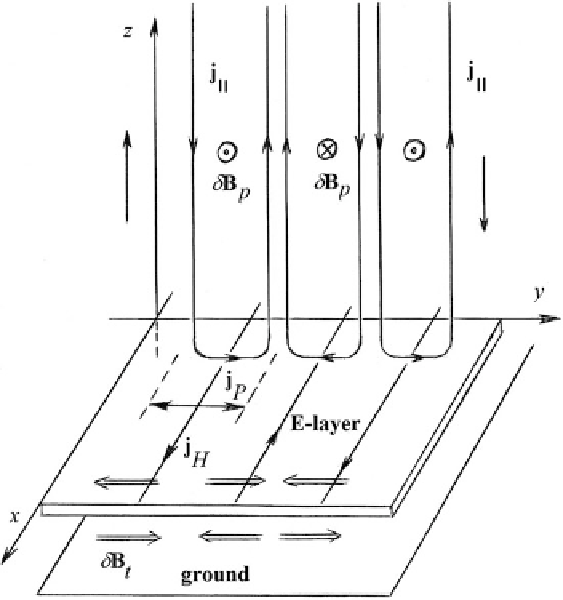Geoscience Reference
In-Depth Information
Fig. 6.6
A schematic illustration of the electric current system and magnetic perturbations resulted
from Alfvén wave interaction with the ionosphere
of polarization mainly due to the conducting E layer of the ionosphere. The high
frequency range of the signal spectrum undergoes strong attenuation since the skin
length of the conducting ionosphere is inversely proportional to the square root of
frequency. In other words, the ionosphere acts as a spatial low-pass filter for the
signals observed on the ground.
To illustrate the rotation of polarization, we will consider the effect of an
incident Alfvén wave on the high-latitude ionosphere. To make our consideration as
transparent as possible, the Earth magnetic field is assumed to be homogenous and
positively parallel to vertical
z
axis. A plane harmonic Alfvén wave propagates
along the magnetic field perpendicular to the ionosphere that are in the plane x;y.
All perturbed values are assumed to vary as exp .iky
i!t/. In the magnetosphere
the Alfvén wave carries transverse polarization of electromagnetic perturbations
and field-aligned current,
j
k
, as schematically shown in Fig.
6.6
. The conducting
E layer of the ionosphere shorts out the field-aligned current thereby exciting the
sheet current system. As the magnetic ı
B
and the electric
E
perturbations in the
magnetosphere are directed along the x and y axes, respectively, the Pedersen
current
j
P
D
P
E
in the E layer of the ionosphere is parallel to y axis while

Search WWH ::

Custom Search